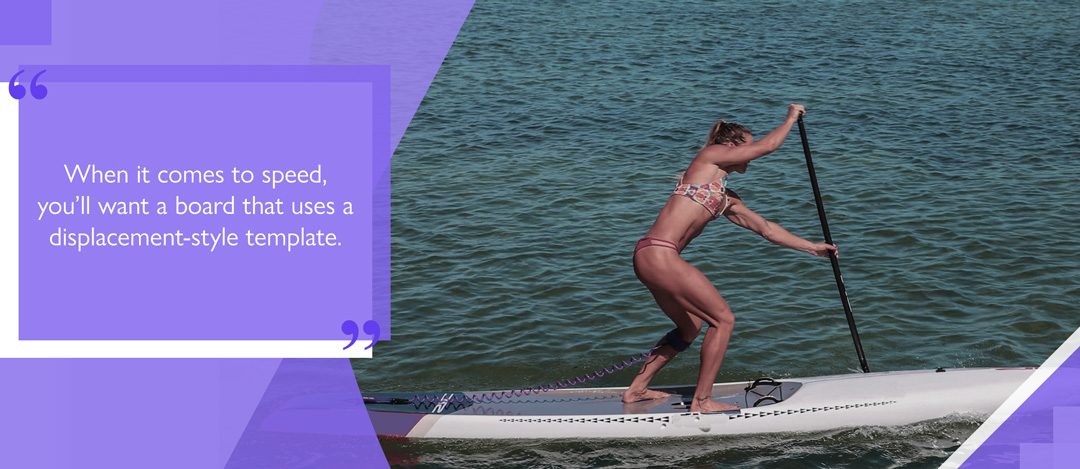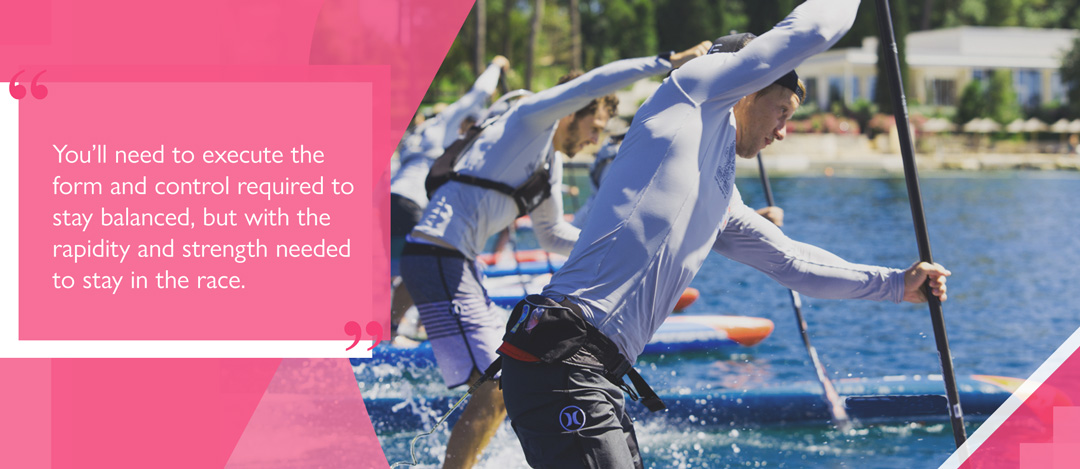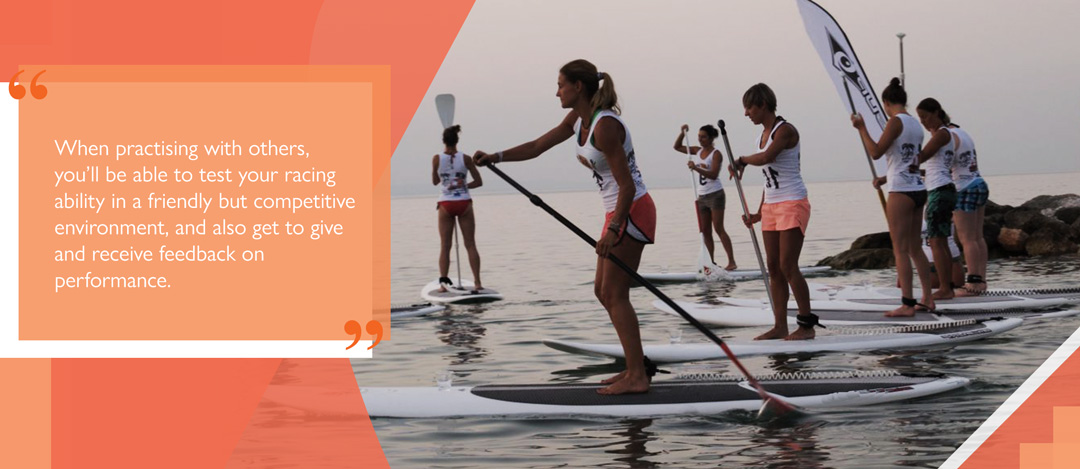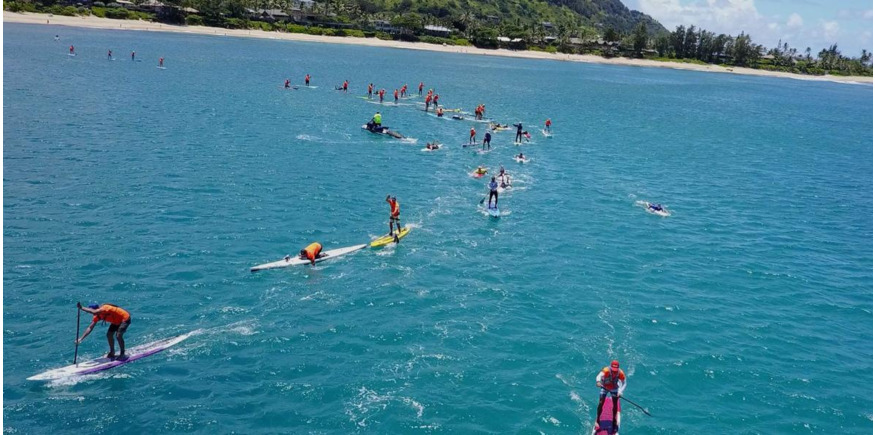For many of us, getting out on a paddleboard is a chance to escape from the world — a time for quiet contemplation or relaxed company, while absorbing and exploring your natural surroundings.
So why turn a relaxing hobby into fast-paced competition? If you’re the sort of person who thrives on extraordinary challenges, then you may be interested in exploring the potential of paddleboarding as a sport. Not only will you get fit, you’ll also discover that it’s great way to socialise.
This article is not intended as an advanced analysis of racing technique. However, if you’re new to racing, it should help you to get started.
Getting your racing kit ready
Choosing a board
It sounds obvious, but you’ll want to make sure you have a SUP that offers the performance you’ll need to compete.
Not all SUP designs are equal: when it comes to speed, you’ll want a board that uses a displacement-style template.
In layman’s terms, that usually translates to a longer, thinner SUP with a pointed nose that encourages the board to cut through waves and glide across the water. It’ll take fewer strokes to cross a flat distance than a board built with a wider deck and stubbier-nosed design, like an allrounder.
A long, lightweight yet rigid inflatable can be a good place to start off. Our 12’0” touring boards provide the right mixture of stability and speed a novice racer can use to develop their skills. Both our Archer Double Chamber and Sport Air models have a narrow, pointed profile which will cut through the water, while offering enough rigidity and volume to keep you planted higher on the water’s surface.

SUP paddle composition
If you want to race, paddle quality is key. A cheap paddle will simply expose you to risk of injury or breakage, while a low-grade aluminium SUP paddle may be too heavy to be effective in a race situation (although it could prove useful as a training aid). A better choice would be a fibreglass or carbon paddle for improved durability, propulsion, and energy efficiency when in use.
SUP accessories
Just as you would on a leisurely paddle, it’s important when training and racing to stay hydrated. Particularly if you plan to be engaged in endurance racing, it may be worth taking a hydration pack with you, which you can sip from at intervals, rather than stop mid-flow to handle a bottle.
Standard SUP safety gear should also be taken out on the water: a personal flotation device and a SUP board leash — you’ll want to retrieve your board quickly if you fall off during a competition.
SUP race rules and categories
No two races will be exactly alike. They may vary in length, depending on racer skill. They could also be hosted in different environments, which will come with their own sets of race rules and challenges. Short course races (between two and four miles) will generally be open to less experienced competitors. Flatwater or contained environments, such as reservoirs, lakes, or marinas, may also provide predictable course conditions that favour a novice racer. However, races also take place in the open sea and on free-flowing rivers.
The start and end of a race may also differ. Whether you begin by charging off a beach into the water or have a floating start, the close ranks of humans jostling for position and an early lead can be chaotic. You’ll need to get confident with paddling (and sprinting barefoot with a board and paddle) in these types of scenarios.
Race classes may also be divided by gender, age (adult or junior) or board length. Regardless, it will be important to pay attention to the rules and confirm with the organisers prior to any race.
Developing your skills
To become an effective SUP racer, you’ll need to be confident handling yourself on a board. With the necessary determination, you can build on your speed, balance, breathing, agility, and strength just by getting out on the water as much as possible. However, you should consider creating a cross-training programme which encompasses activities off the water — alongside a healthy diet packed with natural, organic nutrition.

Paddling technique
Powerful and efficient paddling is the cornerstone of SUP racing success. You’ll need to execute the form and control required to stay balanced, but with the rapidity and strength needed to stay in the race.
Many seasoned racers develop their own advanced variations on the standard five-phase SUP paddling procedure: Reach, Catch, Power, Release, Recovery. When racing, keep your strokes shorter than usual, but with increased frequency. Keeping low, bending your knees, and twisting your hips into the power phase will also help.
All the while, you’ll need to ensure that you’re keeping to the most efficient racing line. Experienced racers often say that it’s important to bring ‘your own’ race, i.e. plot your own approach to each section and waypoint of the course, rather than blindly following the pack. This implies being able to keep your eyes focused on the course and your surroundings, rather than your feet or paddle. It’s also important for ensuring you don’t collide into other competitors!
Turning in the water
Being able to turn quickly is the other fundamental part of the SUP racing experience. The two main types of turn you’ll need to master are the pivot turn and the sweeping turn. Both techniques are explored in depth in our article: How to turn on a stand-up paddleboard.
You’ll want to adapt your turning style to the conditions and course requirements. A pivot turn will cause forward momentum to slow, which may not always be to your advantage when trying to get round a buoy marker. Learning to ‘read’ the situation and what it requires comes with experience.
Sometimes you may have the advantage of being able to use a wave or swell to effectively surf part of a turn, or the wind may be working against you. Practising your skills in all water, weather and wind conditions will naturally make you more able to adapt on the fly.
Some experienced racers suggest that ‘rough water’ training is essential. This includes paddling in waters that have been disturbed by other paddlers and waves that have been reflected off solid objects in the water, such as a bridge or pier.
Training with others
To maximise the potential of your training plan, it will probably be worth seeking outside help. Finding a place where you can get lessons will be a boon — you’ll benefit from the knowledge of someone who has race experience, and / or who can create the sort of personalised training plan for you that will keep you motivated. They’ll also be able to guide you through your weaknesses and help sharpen your strengths.
Practising with a trainer may also expose you to group practice situations, although this is something you can also seek out on your own. Practising with others is a great way to refine technique. You’ll be able to test your racing ability in a friendly but competitive environment, and also get to give and receive feedback on performance. In addition to boosting motivation, you’ll pick up tips from participants and improve your performance — all while having fun!
It’s also worth noting that self-review can be a powerful tool. Videoing yourself or asking someone to record your performance on camera can reveal any glaring issues or areas for improvement, and therefore inform future training.

Finding paddleboard races to attend
Researching race fixtures often means extending your connections in the SUP community. Several organisations exist with the sole purpose of setting up races. Seeking out an organised event can be as simple as picking up a flyer at your local SUP retailer. If you have an instructor or participate in a group, you can also mine their collective knowledge.
Of course, the internet is always a valuable source of information. Keep abreast of what’s happening by following the social media accounts of race organisations and other notable SUP enthusiasts. The websites of renowned SUP publications, paddling schools, as well as the World Paddle Association (WPA), can also be useful resources for event news.
Looking for more ways to extend your experience on the water? Check out some of the other posts on our blog, where we cover a variety of other paddle boarding specialisms, such as SUP fishing, as well as advice on board selection, equipment, and even useful apps. It’s a one-stop shop for handy ideas and information about life out on the water!




